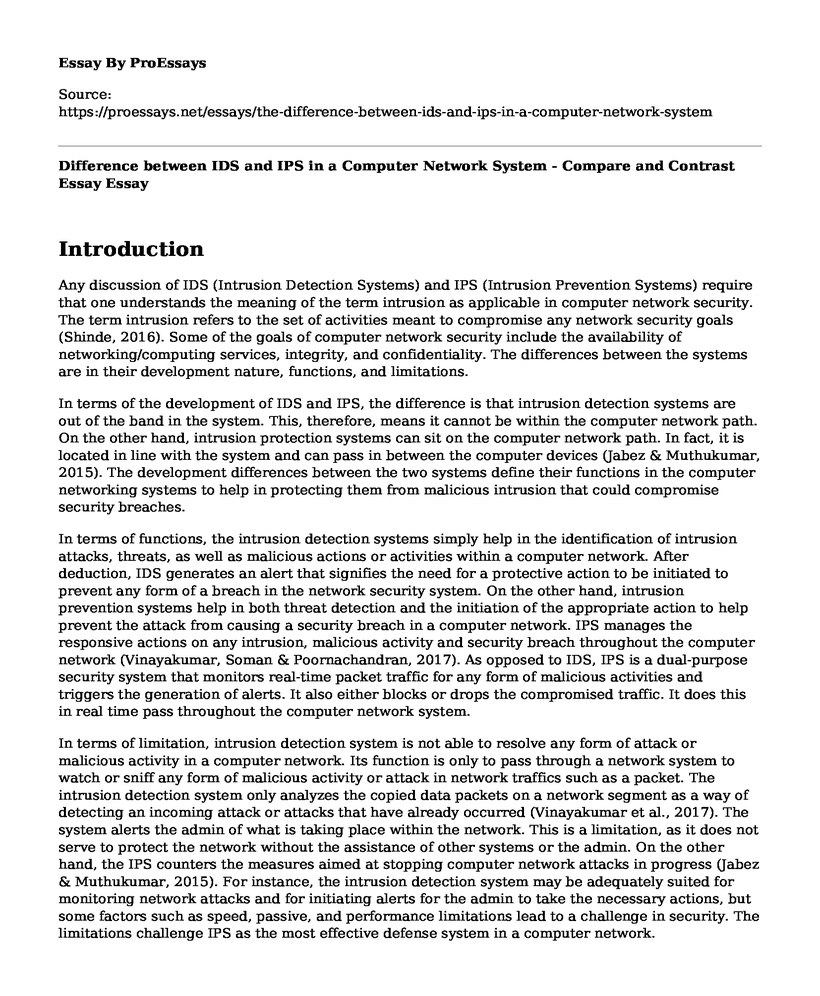Introduction
Any discussion of IDS (Intrusion Detection Systems) and IPS (Intrusion Prevention Systems) require that one understands the meaning of the term intrusion as applicable in computer network security. The term intrusion refers to the set of activities meant to compromise any network security goals (Shinde, 2016). Some of the goals of computer network security include the availability of networking/computing services, integrity, and confidentiality. The differences between the systems are in their development nature, functions, and limitations.In terms of the development of IDS and IPS, the difference is that intrusion detection systems are out of the band in the system. This, therefore, means it cannot be within the computer network path. On the other hand, intrusion protection systems can sit on the computer network path. In fact, it is located in line with the system and can pass in between the computer devices (Jabez & Muthukumar, 2015). The development differences between the two systems define their functions in the computer networking systems to help in protecting them from malicious intrusion that could compromise security breaches.
In terms of functions, the intrusion detection systems simply help in the identification of intrusion attacks, threats, as well as malicious actions or activities within a computer network. After deduction, IDS generates an alert that signifies the need for a protective action to be initiated to prevent any form of a breach in the network security system. On the other hand, intrusion prevention systems help in both threat detection and the initiation of the appropriate action to help prevent the attack from causing a security breach in a computer network. IPS manages the responsive actions on any intrusion, malicious activity and security breach throughout the computer network (Vinayakumar, Soman & Poornachandran, 2017). As opposed to IDS, IPS is a dual-purpose security system that monitors real-time packet traffic for any form of malicious activities and triggers the generation of alerts. It also either blocks or drops the compromised traffic. It does this in real time pass throughout the computer network system.
In terms of limitation, intrusion detection system is not able to resolve any form of attack or malicious activity in a computer network. Its function is only to pass through a network system to watch or sniff any form of malicious activity or attack in network traffics such as a packet. The intrusion detection system only analyzes the copied data packets on a network segment as a way of detecting an incoming attack or attacks that have already occurred (Vinayakumar et al., 2017). The system alerts the admin of what is taking place within the network. This is a limitation, as it does not serve to protect the network without the assistance of other systems or the admin. On the other hand, the IPS counters the measures aimed at stopping computer network attacks in progress (Jabez & Muthukumar, 2015). For instance, the intrusion detection system may be adequately suited for monitoring network attacks and for initiating alerts for the admin to take the necessary actions, but some factors such as speed, passive, and performance limitations lead to a challenge in security. The limitations challenge IPS as the most effective defense system in a computer network.Conclusion
In summary, understanding the difference in the functions does not mean one can work without the other. The two are used together to maintain the maximum security of the computer network data traffic. Both detection and prevention are needed in a computer network system to achieve maximum data protection. The two systems, intrusion prevention systems, and intrusion protection systems are both important in computer network security. Discussion of the functions, limitations, and development nature of the two systems clearly brings out their differences.
References
Jabez, J., & Muthukumar, B. (2015). Intrusion Detection System (IDS): Anomaly Detection Using Outlier Detection Approach. Procedia Computer Science, 48, 338-346. doi: 10.1016/j.procs.2015.04.191
Shinde, S. (2016). Review on Intrusion Detection and Prevention System. International Journal of Engineering and Computer Science. doi: 10.18535/ijecs/v5i11.61
Vinayakumar, R., Soman, K., & Poornachandran, P. (2017). Evaluation of Recurrent Neural Network and its Variants for Intrusion Detection System (IDS). International Journal of Information System Modeling and Design, 8(3), 43-63. doi: 10.4018/ijismd.2017070103
Cite this page
Difference between IDS and IPS in a Computer Network System - Compare and Contrast Essay. (2022, Mar 04). Retrieved from https://proessays.net/essays/the-difference-between-ids-and-ips-in-a-computer-network-system
If you are the original author of this essay and no longer wish to have it published on the ProEssays website, please click below to request its removal:
- Approaches to Improve the Program
- Screening Tools That Internet Service Providers Can Employ in Regulating Web Content
- Bootstrapping in Businesses Essay Example
- The Google Company - Research Paper
- Essay on Security Breaches & Technology: Leveraging for Crime Detection & Prevention
- Research Paper on Google in the US and China
- Free Essay Example on Statistical Data in Healthcare: Examining Significance







